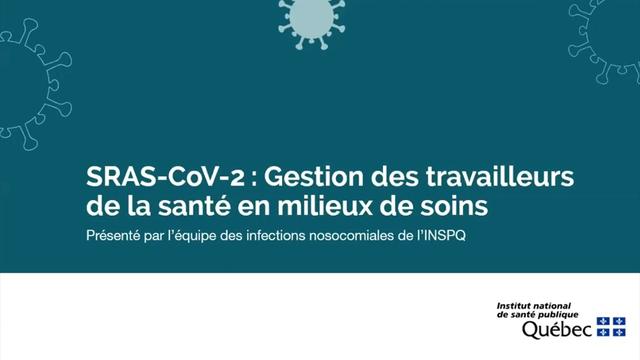Inspq Inspq Center of Expertise and Reference in Public Health SRAS-COV-2: Management of health workers in dental care
The current epidemiological context of a rapid increase in the circulation of the omicron variant, leads us to revise our recommendations.An update will follow shortly.
Good vaccination coverage both in health workers (TDES) in dental environment and in users decreases the risk of transmission in private dental clinics as well as in teaching environments associated with this discipline.The gradual increase in vaccination coverage as well as the presence of worrying variants of the Sras - Cov - 2 in circulation in Quebec influence our recommendations:
Preamble
This document aims to specify the factors to be taken into consideration as well as the measures to be applied when exposure of a dental environment to a confirmed case of COVID-19 occurred in private and public dental clinic as well as in the backgrounds'Teaching associated with this discipline.It must be used as a guide to help decision -making on the measures to be recommended (surveillance of symptoms, infection screening, withdrawal and return to work) for the management of TDES in dental environment.
It should be noted that the management of TDES exposed to COVVI-19 in community as well as that of users exposed to COVVI-19 in dental areas must be made using the following document: COVID-19: Measures for cases managementand contacts in the community: temporary recommendations.These interim recommendations have been drawn up to support public health departments (DSPU) in carrying out COVVI-19 cases and interventions in private and public dental clinics (excluding those located in healthcare areas) as well asin teaching environments associated with this discipline.
The purpose of this document is not to issue recommendations on the wearing of the epis during oral care, but rather to present a risk management process on driving to be recommended for the management of TDES in the middledental.Refer to COVID-19-Buccodentary procedures phase 4: provision of oral services in the context of pandemic for recommendations related to the port of the epis.

The post-exhibition management of these TDES must take into account several factors:
Among the mitigation measures implemented in the dental office, rapid suction is considered one of the main measures allowing the reduction of the emission of aerosols in the.According to data from some journals of the scientific literature consulted, the effectiveness of this measure tends to a significant reduction in source aerosols (Ontario Public Health, 2020b; Harrel and Al., 2004 ;Kumbargere et al., 2020;Samaranayake and Al., 2021;VIRDI ET AL., 2021).Although the level of scientific evidence of this data is not high, this measure was still considered in the risk management process in connection with the assessment of the exposure of TDES in dental environment.
The recommendations are modulated according to the level of protection conferred by immunity.Thus the TDES are considered to be protected, partially protected or unprotected (see section definitions).This classification is consistent with that used in the community and in care.The data currently available on vaccination efficiency and the protection offered by an infection prior to COVVI-19 is sufficient to make it possible to adjust the management of TDES in dental..However, these recommendations will be modified if necessary depending on the evolution of scientific data.
In this document, exposure levels are not qualified at high risk, moderate or low unlike community management.As with recommendations in healthcare environments, measures for the management of exposed TDES are indicated directly according to each type of situation by taking into account the factors (which may increase or decrease the risk) present during exposure.
In certain circumstances, it is possible that a tdes in dental environment which is exposed to a case is not withdrawn from work considering, among other things, all the mitigation measures of the risks put in place in its specific environment.
1 Référer à SRAS-CoV-2 : Choix et port du masque médical en milieux de soins pour les indications du port adéquat du masque.
2 La protection oculaire à usage unique peut être un écran facial ou des lunettes protectrices.Choosing the appropriate eye protection to ensure that the APR or the medical mask does not interfere with the adequate positioning of the eye protection and that the eye protection does not affect the adjustment and the sealing of the APR.Prescription glasses are not considered to be adequate protection.The lateral devices that settle on the sides of the prescription glasses are not considered as an eye protection.
Effects of palm oil on health: what are the dangers?
GO
Vaccination obligation in Lourdes: the employee of a dialysis center dismissed
GO
Charlotte, student midwife: "We are very quickly in autonomy"
GO
Eudaemonism: all about this philosophy of happiness
GO